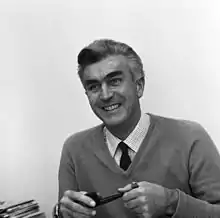John Adams (physicist)
Sir John Bertram Adams KBE FRS[1] (24 May 1920 – 3 March 1984)[2] was an English accelerator physicist and administrator.
John Adams | |
|---|---|
 John Adams in his office at CERN | |
| Born | 24 May 1920 |
| Died | 3 March 1984 (aged 63) Geneva, Switzerland |
| Other names | Sir John Bertram Adams |
| Occupations | Physicist and former CERN Director-General |
| Spouse | Renie Warburton |
| Children | 2 |
Adams is mostly known for his work at CERN and Culham Laboratory. Despite a lack of formal university education, Adams worked for organizations like the Telecommunications Research Establishment and the Atomic Energy Research Establishment in the 1940s and early 1950s. He served as acting director and eventually as elected director of CERN, from 1976 until 1981.
Biography
Early life
Born in Kingston, Surrey on May 24, 1920. He attend Eltham College from 1931 until 1936, after which he began to work for Siemens Laboratories in Woolwich. He continued studying at the South East London Technical Institute until 1939 earning a Higher National Certificate. This was the end of his formal education receiving no university education.[3]
Professional career
At Siemens, his work was concerned with the acoustic properties of telephones. Between 1940 and 1945, he worked the Telecommunications Research Establishment being particularly responsible for developing the microwave radar[4] After, Adams moved to the Atomic Energy Research Establishment until 1953. In 1953, he moved once more to the new CERN Laboratory, serving in the General Physics Division as the engineer in charge of designing and building the Harwell Synchrocyclotron, Europe's first large accelerator[1] which operated successfully for 30 years until shutdown due to lack of funding. Also in late 1953, he was noted serving as a full staff member of the Proton Synchrotron Group. As CERN's proton synchrotron became fully operational in 1959, Adams was important to defining the methods and organization by which physicists would conduct testing. His work organizing CERN's administrative structure and measurement equipment were prepared for experimentation leading up until the synchrotron's start up at the end of 1959.[1] After the death of Prof. C. J. Bakker, CERN Director-General, in April 1960, the Council of CERN appointed Adams to the post of acting Director-General.[5] He held this post until August 1961[6] when he returned to the UK as director of the Culham Fusion Laboratory, and then from 1966 to 1971 he was a member of the United Kingdom Atomic Energy Authority. He also became a Fellow of the Royal Society. Returning to CERN in 1971 as Director-General of Laboratory II, he led the design of the Super Proton Synchrotron. He split the duties of CERN Director General with Willibald Jentschke and then Léon Van Hove during the 1970s. His careful management of CERN's new projects were important to getting funding and approval from CERN's council. His designs were cautious and focused on reliability while providing the ability for new improvements to be built. The Super Proton Synchrotron was able to reach energies of 540 GeV.[1] With the reorganization of CERN in 1976, he became the executive Director-General, working on obtaining funding for the LEP collider.[7][8][9] The new collider used magnet systems for acceleration that were designed by Adams in his previous accelerators. He was knighted in 1981.
Awards and honors
- Rontegen Prize, University of Giessen (1960)
- D. Sc. (Honorary), University of Geneva
- Duddell Medal, Physical Society (1961)
- D. Sc. (Honorary), University of Birmingham (1961)
- Fellow of Royal Society (1963)
- Leverhulme Medal (Royal Society) (1972)
- Royal Medal, Royal Society (1977)
- Knight Bachelor (1981)
John Adams Institute for Accelerator Science
The John Adams Institute for Accelerator Science (JAI), an accelerator physics research institute comprising researchers from Royal Holloway, University of London, University of Oxford and Imperial College London is named in his honour.[11][12][13][14] A main road ("Route Adams") in CERN's Prevessin site is also named after him.
See also
References
- Stafford, G. H. (1986). "John Bertram Adams. 24 May 1920 – 3 March 1984". Biographical Memoirs of Fellows of the Royal Society. 32: 2–34. doi:10.1098/rsbm.1986.0001. JSTOR 770106. S2CID 72330820.
- "Obituary : Sir John Bertram Adams, 63; led European atomic center". The New York Times. Archived from the original on 24 May 2015. Retrieved 2 September 2015.
- Stafford, G.H. "John Betram Adams". Biographical Memoirs of Notable Members.
- Waggoner, Walter H. (8 March 1984). "SIR JOHN BERTRAM ADAMS, 63; LED EUROPEAN ATOMIC CENTER (Published 1984)". The New York Times. ISSN 0362-4331. Retrieved 9 March 2021.
- "J. B. Adams : acting Director-General". CERN Courier. CERN. Retrieved 1 September 2015.
- "Decisions of the 18th Council". CERN Courier. CERN. Retrieved 1 September 2015.
- "Homage to Sir John". CERN Courier. 24 (6): 232–236. July 1984.
- "Sir John Adams 1920-1984". CERN Courier. 24 (3): 91. April 1984.
- "John Adams: Project Director". CERN Courier. 8 (12): 310. December 1968.
- The Star Press (Indiana) 11 March 1984 page 38. Read on Newspapers.com on March 26, 2023.
- "History". John Adams Institute for Accelerator Science. Retrieved 1 February 2021.
- "About us". John Adams Institute at Imperial College. Retrieved 1 February 2021.
- "John Adams Institute for Accelerator Science". University of Oxford Department of Physics. Retrieved 1 February 2021.
- "John Adams Institute for Accelerator Science". Royal Holloway, University of London. Retrieved 1 February 2021.
External links
 Media related to John Adams (physicist) at Wikimedia Commons
Media related to John Adams (physicist) at Wikimedia Commons- The John Adams Accelerator Institute